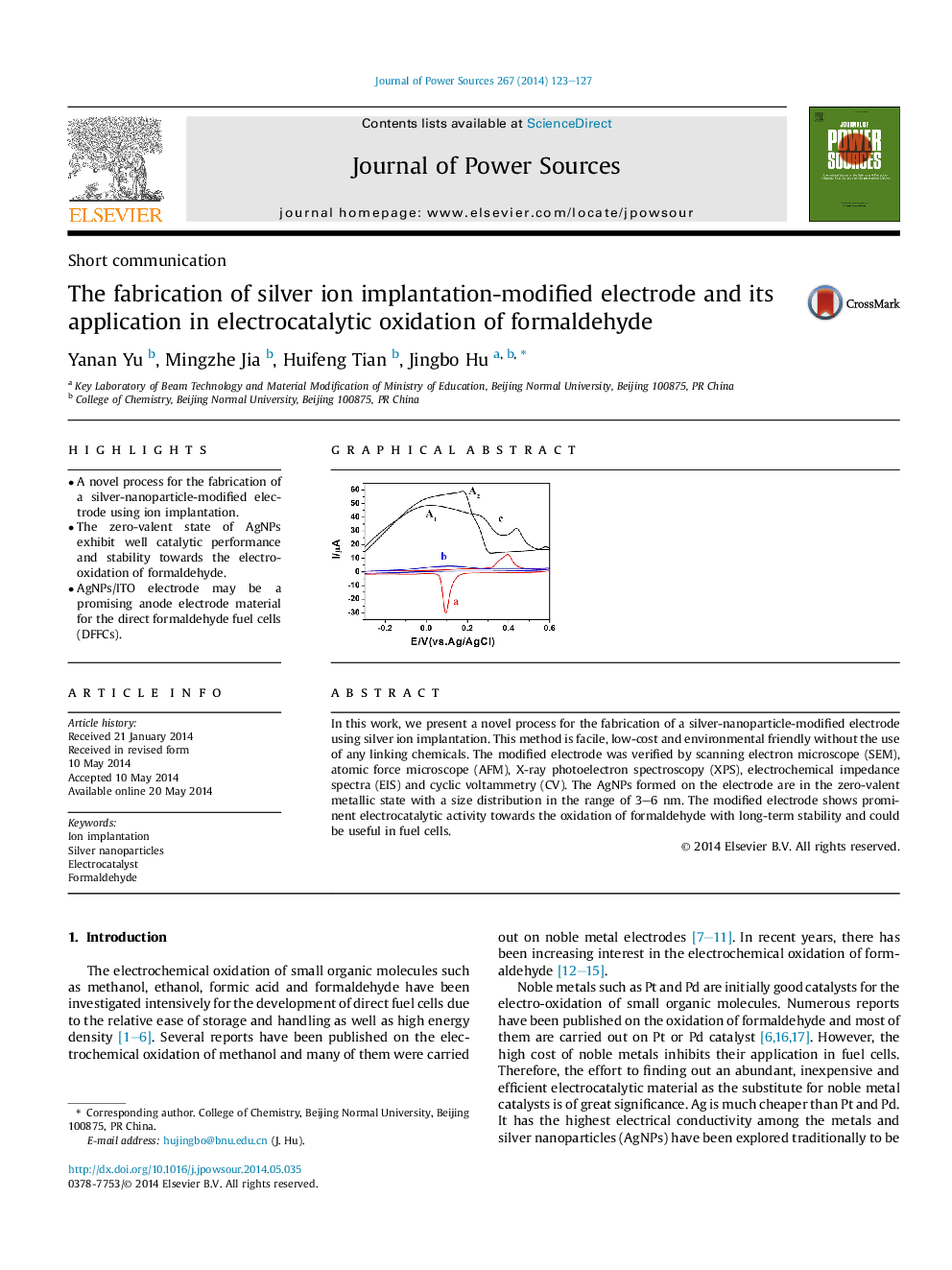| کد مقاله | کد نشریه | سال انتشار | مقاله انگلیسی | نسخه تمام متن |
|---|---|---|---|---|
| 1286574 | 1497965 | 2014 | 5 صفحه PDF | دانلود رایگان |
• A novel process for the fabrication of a silver-nanoparticle-modified electrode using ion implantation.
• The zero-valent state of AgNPs exhibit well catalytic performance and stability towards the electro-oxidation of formaldehyde.
• AgNPs/ITO electrode may be a promising anode electrode material for the direct formaldehyde fuel cells (DFFCs).
In this work, we present a novel process for the fabrication of a silver-nanoparticle-modified electrode using silver ion implantation. This method is facile, low-cost and environmental friendly without the use of any linking chemicals. The modified electrode was verified by scanning electron microscope (SEM), atomic force microscope (AFM), X-ray photoelectron spectroscopy (XPS), electrochemical impedance spectra (EIS) and cyclic voltammetry (CV). The AgNPs formed on the electrode are in the zero-valent metallic state with a size distribution in the range of 3–6 nm. The modified electrode shows prominent electrocatalytic activity towards the oxidation of formaldehyde with long-term stability and could be useful in fuel cells.
The cyclic voltammetry (CV) of the silver nanoparticles modified indium tin oxide (ITO) electrode (AgNPs/ITO) in the absence of formaldehyde (a), bare ITO (b) and AgNPs/ITO (c) in the presence of 0.1 mM formaldehyde in 0.1 M NaOH. The line c shows two irreversible current peaks during the formaldehyde oxidation: a forward (peak A1) represents pronounced formaldehyde oxidation during the anodic scan. The other large oxidation current (peak A2) in the reverse scan is attributed to the removal of the incompletely oxidized carbonaceous species formed in the forward scan. According to the CV results and previous reports, we elucidated following mechanism of the formaldehyde oxidation. The formaldehyde is oxidized to CO2 via a dual path mechanism, which involves a reactive intermediate and adsorbed CO as a poisoning species. In one pathway, direct oxidation of formaldehyde is said to occur (pathway2) whereas in the other pathway, formaldehyde is oxidized to CO (pathway 1), which in turns must be removed. At higher potentials, a quick increase in current is observed during the intermediate oxidized further by silver (I), which aids in transforming the poisonous intermediates to CO2 resulted from formaldehyde. The surface poison shown in pathway 1 can be removed by reacting with OHads.HCHO + H2O → CH2(OH)2pathway 1:CH2(OH)2 + Ag + 2OH− → Ag-COads + 3H2O + 2e−Ag + OH− → Ag-OHads + e−Ag-COads + Ag-OHads + OH− → 2Ag + CO2 + H2O + e−pathway 2: CH2(OH)2 + Ag + 3OH− → Ag–COOH + 3H2O + 3e−Ag-COOH + OH− → Ag + CO2 + H2O + e−During the above process, the formation and adsorption of intermediates (CO) poisoned the electrode surface, but the results reflected that the AgNPs/ITO electrode possessed a high resistance to CO during formaldehyde oxidation. So the AgNPs/ITO electrode had an acceptable electrocatalytic activity towards the electro-oxidation of formaldehyde.Figure optionsDownload as PowerPoint slide
Journal: Journal of Power Sources - Volume 267, 1 December 2014, Pages 123–127
